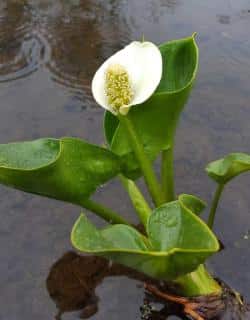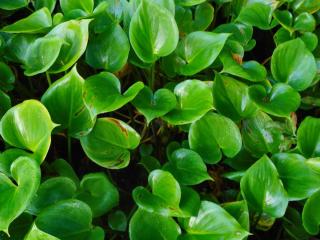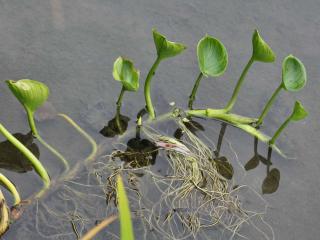

Marsh arum Calla palustris shines in the shade, producing lovely aquatic flowers.
Key Marsh calla facts:
Name: Calla palustris
Common: water arum, marsh calla
Family: araceae
Type: perennial aquatic plant
Height: 6 to 12 inches (15 to 30 cm)
Exposure: shade or bright
Soil: wet, aquatic, soggy
Foliage: deciduous – Flowering: spring, summer
Hailing from the chilly and temperate regions of the northern hemisphere, Calla palustris naturally grows in bogs and ponds.
Its leaves resemble a heart. Early summer brings a white spathe that wraps around a green-yellow spadix. Much like other arums, it bears a bunch of red berries as fruit. Both flowers and fruits stand out. In fact, in the shade, this marsh arum faces little competition and can form dense clusters.
Important note: In some parts of Europe (France), marsh arum is a protected species. So never pick it in the wild. Only shop for these plants at garden centers.
Plant your Calla palustris ASAP after purchasing. Stores typically offer potted plants, but occasionally you’ll find bare-root ones. Plant the bare-root ones during cool weather or any time the ground isn’t frozen solid. Spring pots are usually available from early May to June, while fall ones come around from late August to September.
 Put the potted content into humus-rich, acid, muddy (wet) soils in partial shade.
Put the potted content into humus-rich, acid, muddy (wet) soils in partial shade.Ideal planting zones include bogs, marshes, pond outskirts, or slow stream edges.
 Growing arums is zero-effort as long as soil stays consistently moist or even wet.
Growing arums is zero-effort as long as soil stays consistently moist or even wet.
So, once your plants are settled in, let nature do its thing.
→ Good to know: light mulch comes in handy during particularly cold, snowless winters.
Marsh arum can’t survive an extended dry spell.
 Calla palustris naturally spreads through its seeds and rhizomes, all on its own.
Calla palustris naturally spreads through its seeds and rhizomes, all on its own.
When sowing its seeds, note that they may take time to sprout. Often, this species struggles to mature from seeds. Dormant mechanisms indeed prevent germination. You need to break this dormancy before seeds decide to grow.
The way to go is stratification: you must simulate a cold winter season. Store the damp seeds in the fridge for a while, anywhere from one to six months.
A simpler approach is to let nature handle the stratification. Sow seeds on a weed-free site late in fall or winter. Safely nestled under snow, these seeds get conditioned by the elements, gearing up for germination in upcoming growing seasons. Seeing your first bloom might take 2 to 3 years.
No issues with either bugs or diseases.
The Calla palustris species bears a resemblance to Zantedeschia aethiopica.
Watch out: don’t confuse Calla with Caltha, especially Caltha palustris. Both are aquatic, but they’re distinct plants, even if their names might trick you.
The Calla genus name likely stems from the Greek word kallos which means beauty. Its specific name translates to “marsh lover.”
Every part of this plant, as for all arums, is toxic. Swallowing causes intense mouth pain. Symptoms include burning sensations and swelling of lips, mouth, tongue, and throat, eventually making talking tough. This toxicity arises from calcium oxalate crystals.
Discover more: